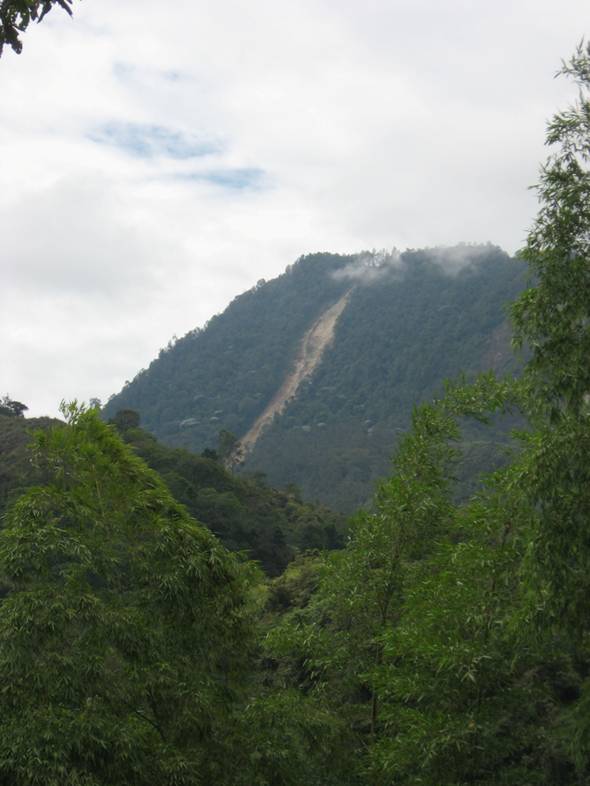A landslide from too much rain in Colombia (photo courtesy of Equal Exchange)
The Yale Forum on Climate Change and the Media, June 7, 2011

That morning ritual, reading the newspaper while sipping coffee, already has given way to peering at the computer over the mug. And now the coffee in this ritual, like printed newspapers, is itself in some trouble, and not just because some new chai latte is upstaging it.
Sustained rains, droughts, higher temperatures, diseases, and pests attributed to climate change are hurting coffee crops and production. Wholesale prices worldwide are roughly double what they were a year ago. These worries aren’t new or fanciful. They point to disasters going on right now. Climate change is rocking coffee farming.
“We are definitely getting reports and seeing for ourselves that climate change is real; it’s hitting the coffee growers,” said Rodney North, a spokesman for Equal Exchange, a Massachusetts-based cooperative that imports fair-trade coffee. “It’s already a mountain crop — certainly the best stuff is. If in fact it’s an option to go up the mountain, mountains get smaller as you go up them. Certainly there’s less appropriate land available. That would mean clearing more forest, which we don’t want to see.”
Scientists and those in the coffee trade say that coffee’s ideal zone for growth is either creeping to higher altitudes, in the case of the better-tasting (most agree) Arabica coffee, or moving to different areas in response to flood or drought, in the case of lower-elevation Robusta coffee. In many areas of Costa Rica, pineapples have replaced coffee. (Check the tags on those pineapples in the supermarket. Eaten much pineapple with your morning newspaper lately?)
Coffee demand is up and coffee exports hit a record last year. As some countries have struggled with changing conditions, others, like Vietnam and Brazil, have stepped up coffee production in the past decade or so. How long can farmers meet such demand given what’s going on in stronghold growing areas? Experts can’t say with confidence.
The wholesale price of coffee rose more than 82 percent between last April and this April, to $2.34 per pound, according to the International Coffee Organization. In mid-May the price was at $2.18. Reasons for this rise include the high price of oil and rising transportation expenses, world demand, and supply.
For journalists, the stories in the emerging, let’s call it, “coffee catastrophe,” are many and varied, and still new. They will unfold for many years in Colombia, Costa Rica, Brazil, Uganda, Vietnam, and other regions the world relies on for its coffee fixes.
Coffee in many ways may be a key sentinel for climate change. Native to Africa, where it naturally grows for many decades as a forest understory plant (beneath trees) at elevations mostly above 1,500 feet, coffee has grown at similar latitudes across two oceans: in South and Central America, and in Southeast Asia. Vietnam has become an important coffee producer. Because of political problems and climate change, Africa’s production is down 40 percent.
Colombia: Incessant Rain for Three Years
Nowhere are the coffee challenges more dramatic right now than in Colombia. For three years seemingly nonstop rain has reduced coffee harvests there dramatically. Five years ago the Colombian government set itself a goal to produce 17 million bags of beans per year by 2014. But last year the country produced only 8 million bags.
“That’s the lowest amount it’s produced for about 20 years. and that’s despite all their best efforts,” said Peter Baker, senior scientist for commodities and climate change for CABI International, a nonprofit that promotes methods to help farmers deal with changing conditions around the world.
Baker believes that climate change’s effects are clear in Colombia. “The Colombians are very organized about producing coffee,” Baker said. “They have done everything by the book, and it hasn’t worked. You have to conclude that the game has changed, really. Producing coffee has become more difficult.”
When this period of rain stops, as it’s expected to when La Niña (periodic ocean cooling) ends next year, hotter temperatures will stress the coffee more, reducing quality and yields, Baker said. (Worldwide production in the 2010-11 season was 133 million bags.)
Things are rough in other coffee-production countries, too. Todd Caspersen, director of purchasing for Equal Exchange, has talked to farmers in Peru struggling with altering rainfall patterns and a change in cloud covers. “In this particular part of northern Peru, the cloud layer used to be higher up the mountainside,” Caspersen said. “It has dropped way down now, which has increased the incidence of disease in the crops.” The cloud cover remains for months at a time. Farmers are trying to learn to deal with a fungus infection, “which is something they didn’t have to do before,” he said.
One of the fundamentals of coffee farming is that it involves long-term investments. It takes three years to get a crop, so relocating to new locations is no easy decision. “What worries me is, you will find less investment,” Caspersen said. “It’s very concerning to me: will there be coffee in six years?”
In Africa, Caspersen said, mountainous coffee farms near Kilimanjaro (in eastern Africa) and Mount Elgin (in Uganda) both are losing glacier cover. Those losses are not necessarily related to climate change, scientists say, but the reality is that coffee needs that water to survive.
The ‘Goldilocks plant’
Even without unusual or extraneous pressures, coffee crops are finicky. They depend on a particular sequence of conditions throughout the growing season. Even small changes in rainfall or temperature debilitate coffee.
“Coffee is a Goldilocks plant,” said Cabi International’s Peter Baker. “It likes it not too hot, not too cold, not too dry, not too much shade, not too much sun.”
First, coffee crops prefer a dry period of a few weeks. That stresses the plant into flowering, Baker said. “Then it needs a good soaking to stimulate the actual opening of the flowers, and then it needs periodic rain from then on, to fill the berries. And during the flowering stage, the temperature mustn’t go over 33 centigrade [91.4 degrees F]; otherwise the flowers will abort.”
With that special sequence, a lot could go wrong even in the most predicable climates, but now coffee’s strongholds are changing. In Colombia for the past three years — and experts predict more of the same next year — coffee plants aren’t getting the dry periods they crave. Rainfall has been 100 to 150 percent more than usual the past three years. So the flowering isn’t going well. Also, the continuous rain has led to coffee rust, a fungal disease.
“The severity of the situation and the — I don’t know if it’s actually record breaking, I think it must be by now — the amounts of rain: climate change is part of it,” Baker said. (He’s right about the record. This year’s rainy season in Colombia was the worst in history, the BBC reported.)
Average temperatures are rising in coffee-producing countries, and the beans are now ripening more quickly than they did several years ago, Baker has found. Quicker ripening lowers the quality of the beans. If average temperatures rise by 5.4 degrees Fahrenheit by 2100, the lowest altitude where Arabica coffee (the best-tasting coffee) can survive will move upward about 150 feet per decade, according to Baker.
As a result, he said, “At the lower edges, those farmers are going to go out of business in the next few years,” he said.
All of the changes in coffee regions suggest that land elsewhere, unsuitable for coffee now, could support it. That appears to be the case so far in Indonesia, where some farmers are growing coffee on deforested land. But there’s the obvious catch: The cutting down of giant, old trees to grow other crops exacerbates climate change because it removes those trees as carbon sinks.
For the time being, coffee crops are keeping up with demand, but barely. There’s enough coffee worldwide, but the inventories have gone way down: Baker said that coffee inventories worldwide were 20 to 30 million bags several years ago. Now the amount in storage is only 5 million.
Baker says he thinks coffee will remain a part of the morning ritual, but that keeping it there will cost more and require farmers to continue adapting to a warmer world.
CABI has begun a project to advise farmers in some of the coffee-growing areas on just how to adapt. In Mexico, Panama, and other Central American countries, where drier conditions are expected, they will try strategies designed to shade plants and help retain soil moisture. In countries where wetter conditions arise, they are working on techniques to survive hurricanes and downpours. When droughts come, farmers must be prepared for pests, especially the coffee berry borer.
Soon it will be time to retire the old joke about “that and 50 cents will get you a cup of coffee.” The fuel of the Western world’s morning mind seems to be moving into the realm of a delicacy, perhaps along with truffles and foie gras. The loss of a good hot drink is the least of it, though. The potential disasters in coffee farms could destroy livelihoods, in some cases threaten people’s lives, and be forerunners of other problems to come.
About This Article
Bud Ward assigned this piece after he heard a dispatch on the public radio program, “Marketplace.” Coffee’s woes worldwide ought to lead to many more stories. I felt we are just laying out the hugeness of this one.
